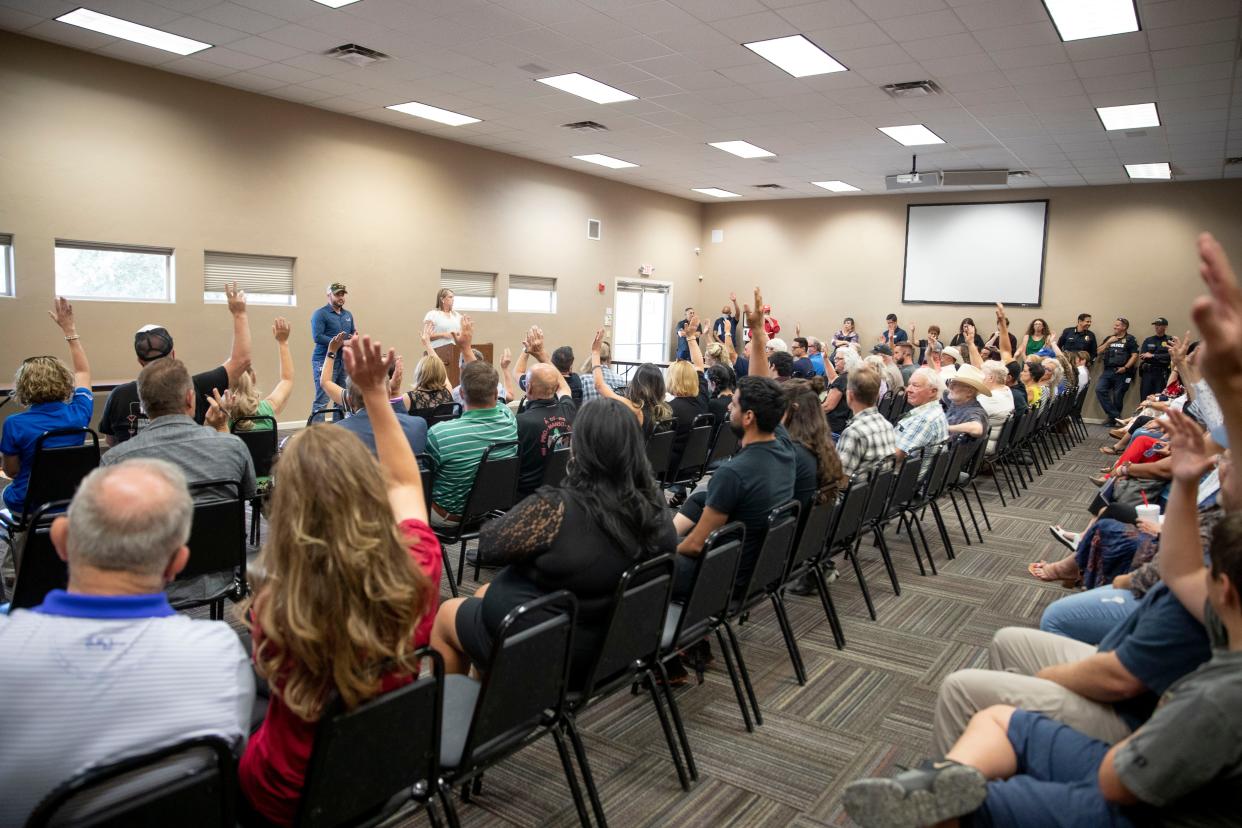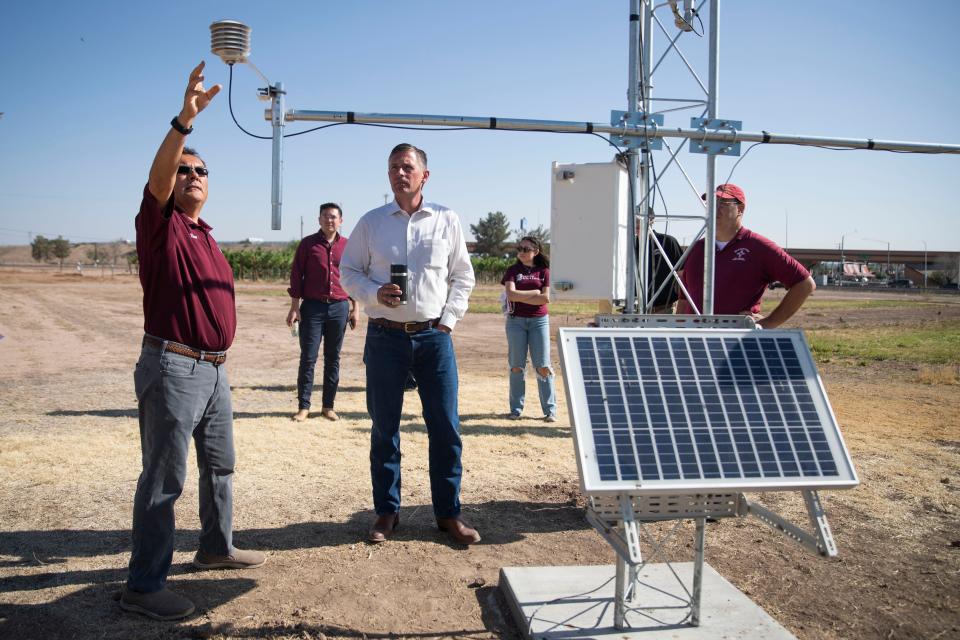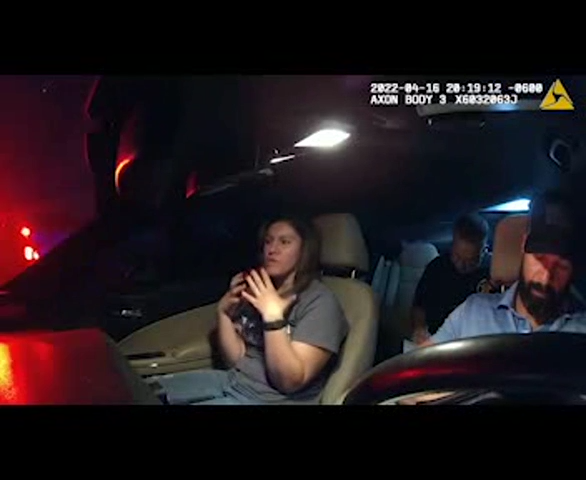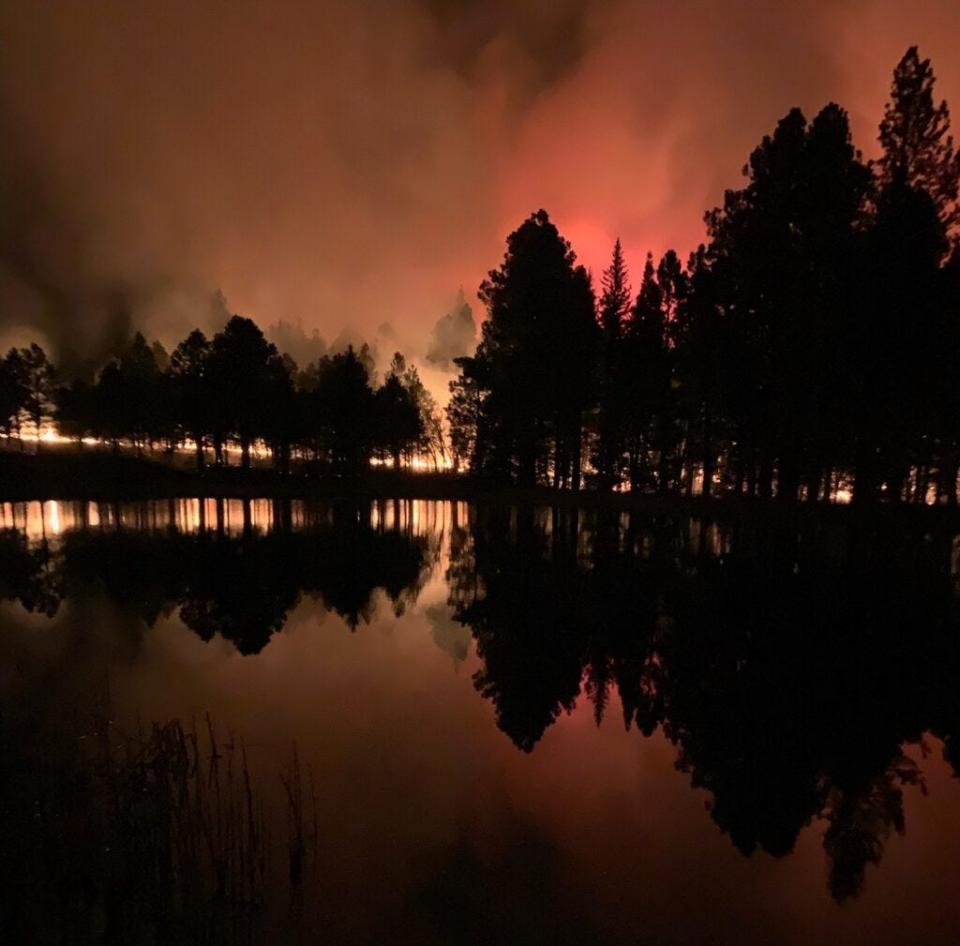Public safety forum, Amelia Baca shooting, and fires, fires, fires

- Oops!Something went wrong.Please try again later.
Locals call for public safety reform at forum
During a public forum to address business owners’ concerns about crime and unhoused people, Las Cruces Police Chief Miguel Dominguez criticized bail reform measures and called for more nonviolent offenders to be held in jail for longer.
The Las Cruces Association of Realtors, Las Cruces Home Builders Association and Greater Las Cruces Chamber of Commerce convened the public forum on Thursday, June 2, to allow city officials and law enforcement the chance to respond to theft, vandalism and property damage experienced by the city's business community.
Attendees were critical of bail reform, which they dubbed a “catch and release” criminal justice system that they argued enabled criminal activity in the area. One attendee said, “It is easy to be a criminal in Las Cruces.”
Mayor Pro Tempore Kasandra Gandara, who represents District 1 on the city council, also addressed attendees. She said compassion and accountability need to go hand in hand when approaching the issue of crime and homelessness. She said many times people have lasting trauma from past experiences that affect the way they behave now.
Reporter Michael McDevitt, who covers city and county government for the Las Cruces Sun-News, attended the meeting last week. Michael said:
When reporting on this public safety forum, I felt the need to cut through the fat to get to the real story. As a newspaper, we’ve reported before on the concerns about crime and how the business class in town is upset at their experiences of property crime and the presence of unhoused people on their property. Those viewpoints were all expressed again here — the same can be said for the proposed solutions discussed by Mayor Pro Tem Kasandra Gandara.
What was new was the police chief’s indignation about bail reform. We had never reported his views on this before, (nor had our public safety reporter heard him speak about this when I asked him).
When reporting a story, it’s important for a journalist to make sure they don’t fall into the narrative presented by the organizer of an event out of mere convenience. Sure, I could have written about the continuing concerns about crime, unhoused people and behavioral health, but it’s not exactly breaking news. By focusing on the chief, we have informed the community of the perspective of one of its major figures and allowed that community to decide what they’ll make of it.

Weather technology expands monitoring capability across NM
New Mexico’s ZiaMet MesoNet Weather Monitoring Network will be expanding significantly over the next year as $1.8 million in federal funds have recently been appropriated toward the effort.
U.S. Senator Martin Heinrich (D-NM) was in Las Cruces Thursday at the Fabian Garcia Research Center following his support of the Fiscal Year 2022 Omnibus Appropriations Agreement which set aside over $2 million in federal funding for southern New Mexico weather monitoring and public safety.
The state’s weather monitoring network is based out of Las Cruces at New Mexico State University. State Climatologist David DuBois explained that there are currently 31 weather stations operating throughout the state, but this bypasses several counties and large portions of more rural areas of the state.
Stations monitor surface weather conditions and sub-surface soil conditions. Data is collected and used to understand patterns and predict future climate numbers. Data is shown online at https://weather.nmsu.edu/ and is updated hourly.
This data is helpful for those in the agricultural industry, emergency responders and managers as well as everyday people who may experience health risks when not properly informed about the changing weather conditions. Data will also aid in making better firefighting decisions when it comes to wildfires in the state.
Reporter Leah Romero accompanied Heinrich as DuBois showed him how the new equipment will benefit New Mexicans. Leah said:
U.S. Senator Martin Heinrich was in Las Cruces last week to better understand how recent federally allocated funds will help improve New Mexico's weather monitoring system. There are only 31 weather stations currently in operation in the state. By July of 2023, there should be 215 total stations.
He and David DuBois explained that the increased number of stations will allow for more accurate data to be collected and fill in gaps across the state.
Sun-News photojournalist Meg Potter and I headed out to the Fabian Garcia Research Center Thursday to hear about the plans and take a look at one of the weather stations in Las Cruces located on New Mexico State University's main campus.

New details emerge in Amelia Baca shooting
In the week leading up to the deadly police killing of Amelia Baca, her mental health condition had declined drastically. She'd gone from having occasional struggles to struggles every other day.
According to newly released police interviews, her family considered putting her into a nursing home or finding alternative means to care for her as an unknown form of dementia ran its course. A week later, Baca, 75, was dead.
On April 16, a Las Cruces Police Department patrol officer shot Baca twice, killing her, as he responded to a behavioral health call. The call came from Baca's daughter. She called 911 and requested aid as she barricaded herself inside the house and away from her mother, who she said was threatening to kill her.
Justin Garcia, who covers public safety for the Sun-News, has been following this case closely. He requested the body-cam videos, which shed more light on Baca's gradual mental decline. Justin said:
Last week, a friend asked a question in a group chat that was mundane in nature. Its answer is heartbreaking, however. After seeing a woman walking down a busy Las Cruces street, she asked the chat if there was someone (other than the police) who she could call. The woman was naked and ranting into the air, having a lively conversation with a ghost. My friend was concerned. Clearly, this woman was out of her mind and at risk of injury or exploitation.
The answer to her question, as many of you guessed, is no. The only institution you can call for almost anything in Las Cruces is the police.
We have more understanding of mental health now than ever before in human history. And yet our most critical institutions, those collectively combined in the category of criminal justice, seem unable or unwilling to take much of this knowledge into account.
When things like trauma and disability aren't taken into account, the consequences are horrific.
I have no doubt that the family of Amelia Baca wishes there would have been someone other than Las Cruces police they could've called. But there wasn't.
The only thing that stands in the way of creating an institution that respects reality and acknowledges the human experience instead of criminalizing it is our willingness to create it. The cost of doing so is measured in dollars and time. The cost of not doing so is measured in lives.
ICYMI: The Reporter's Notebook Podcast, Ep. 18: Amelia Baca

Fires, fires, fires
Growth slowed down significantly on the Black Fire last week, though it continues to tear through the Gila National Forest.
While the fire still continues to grow, it remained down from the more than 15,000 acres the wildfire was gaining almost daily just a week before. As of Friday morning, June 3, the fire had burned 264,657 acres of Gila National Forest land. Perimeter containment was up slightly at 29%.
The fire has officially been burning for three weeks now. The exact cause of the fire is still under investigation but is described as human-caused.
According to the U.S. Forest Service’s daily update, growth has largely focused on the southeast portion of the fire, below Hermosa. The fire has moved east of the area near Animas Creek where the fuels are largely grasses. The change from timber to grass has given firefighters a chance to build direct control lines limiting growth.
Meanwhile, the Hermit's Peak/Calf Canyon fire, which started April 6, continues to burn in northern New Mexico, around Las Vegas. It has since become the largest wildfire in the state's recorded history. (The Black Fire has now entered the top 5.) Last week, it was announced President Joe Biden will visit New Mexico this week to see the damage the fires have caused.
Over Memorial Day weekend, the Foster Fire was first reported May 29 in the Peloncillo Mountains of the Coronado National Forest in New Mexico's bootheel, about 22 miles south of Rodeo. As of our most recent reporting, the fire was around 7,500 acres.
Sun-News reporter Leah Romero has been covering wildfires as they've broken out across the state. Leah said:
Growth on the Gila National Forest's Black Fire was the slowest this week since the fire started in mid-May. It has burned more than 260,000 acres at this point and remains the third-largest fire in New Mexico's history. U.S. Forest Service crews are still working on building containment lines and monitoring for internal hotspots. Last weekend, another fire started in New Mexico's bootheel. The Foster Fire is largely contained now, but New Mexico's fire season is still ongoing and more wildfire starts are still possible throughout the state.
On behalf of all of us at the Las Cruces Sun-News, thanks for reading this week's newsletter.
Damien Willis is a Lead Reporter for the Las Cruces Sun-News. He can be reached at 575-541-5443, dwillis@lcsun-news.com or @DamienWillis on Twitter.
This article originally appeared on Las Cruces Sun-News: Public safety forum, Amelia Baca shooting, and fires, fires, fires

